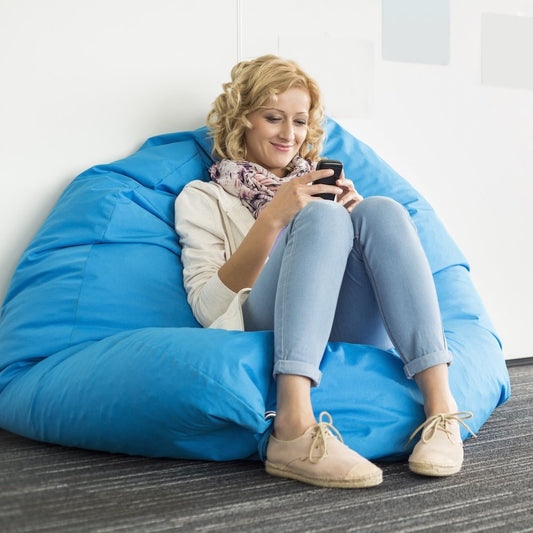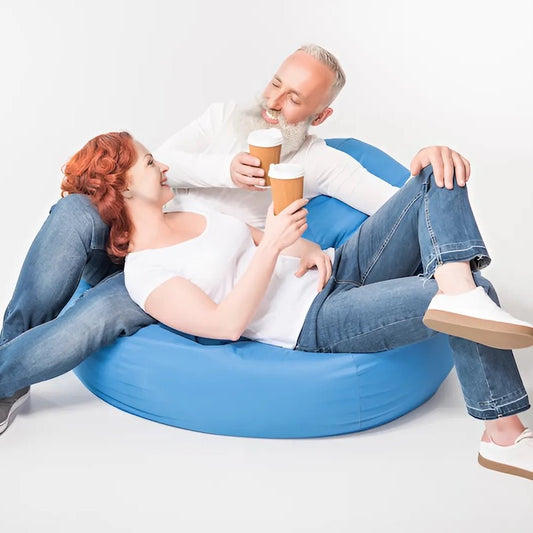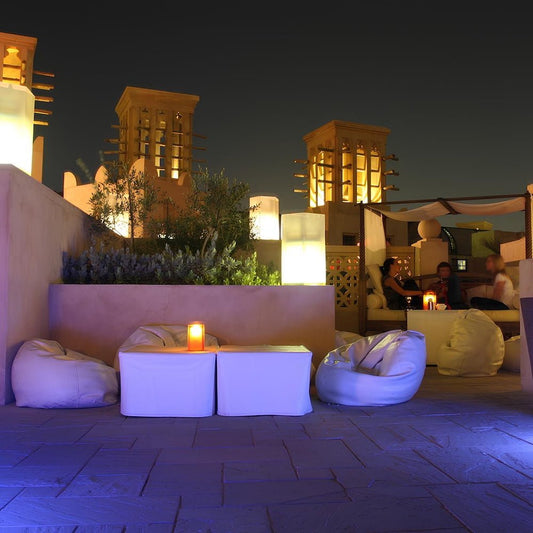When a material is waterproof, it fits into criteria outlined by a governing specification and clear conditions of a laboratory test. In essence, waterproof fabrics are materials that are resistant to penetration by water. This type of waterproof fabric is an invaluable tool when it comes to making household goods, outdoor clothing, shoes and other lifestyle equipment. Waterproofing agents can adhere to the material during the manufacturing process. The end product may then be waterproof. When creating the world's best waterproof bean bags, we had to find the best fabrics. Let's explore some of the most common types of waterproof fabric that are in circulation today.
Useful Terms Regarding Waterproof Fabric
Before we delve deep into waterproof fabric, it is essential to distinguish the difference between a few related, but not identical, terms with regards to fabric. You may have come across these terms before when buying furniture for your home, interior accessories or clothing. Understanding the difference will give you an obvious idea of what a waterproof fabric is.
Waterproof Explained
When a fabric is waterproof, it is impenetrable to water to an extent. Its ability to repel water is measured by testing how much pressure it can take before water begins to seep through. Fabric can only be referred to as waterproof if it possesses sealed seams. Provided it has that quality it can be considered waterproof. The quality of the enclosures and seals will determine how waterproof a product is. An excellent example of waterproof fabric is polyester fabric; this is a material that is highly unlikely to absorb moisture. We can weave polyester tightly to prevent water from passing through it. So it is very effective for producing household items such as beanbags and furniture. So is polyester waterproof?
Water Repellent Explained
The manufacturing process of water-repellant fabric makes it quite difficult for water to penetrate the fabric. Water repellent products usually possess some form of coating, rather than comprising the actual fabric itself.
Water Resistant Explained
This type of fabric resists water penetration. It will not keep you dry in any extreme weather, perhaps a very light rain drizzle. These types of fabrics offer a minimal amount of protection. So waterproofing is the highest level of protection you can get against moisture. Below we discuss water-resistant fabrics in more detail.
How is Waterproof Fabric Made?
Before we explore the different types of waterproof fabrics, let's take a look at their construction. A membrane is a layer of waterproof material bonded to the outer shell of a product or piece of equipment. The main types of waterproof, breathable fabrics, also known as WPB fabrics, consider two types of membrane. The first one is PU which stands for polyurethane, and the second is an ePTFE membrane or expanded polytetrafluoroethylene. Bob Gore developed and created the very first ePTFE fabric in 1978. He called it Gore-Tex. We will discuss Gore-Tex in more detail below. Essentially, Bob Gore found out that when he stretched PTFE, it formed a waterproof surface with millions of tiny pores. These pores are 700 times larger than a water vapour molecule and 20,000 times smaller than a water molecule. The difference in size means that liquid water is unable to penetrate through the membrane. But gaseous water vapour can. PU coating on fabric has no pores, which makes it less breathable than ePTFE. Polyurethane also attracts water to the surface. The skin repels moisture in a process called molecular wicking. PU membranes don't always function well in damp and humid environments, although many manufacturers are developing a more breathable version of this fabric.
8 Common Types Of Fabric - Are They All Technically Waterproof?
1.Laminated Cotton
Laminated fabrics such as cotton are prevalent and effective. A thin waterproof coating is given to the cotton to make it waterproof. This version of waterproofing is also much more environmentally friendly than other sources as one side is a natural fabric. Laminated fabric is ideal for hats, jackets and ski clothing; it works well in extreme weather conditions. A water-resistant layer is bound to the back of the cotton, which enhances the waterproofing. Although the fabric becomes less malleable after this process, it creates a strong structure and is still very breathable.
2. Polyester and Nylon
When they stand alone, polyester and nylon aren't waterproof in their own right, but they are water-resistant due to their tightly knit weave. Again, a special coating can make them waterproof; a layer of polyurethane on the interior of the fabric allows it to withstand rain and other water splashes. Polyester and nylon are much less breathable, and they aren't quite as strong as others. Ripstop nylon fabric can't go unnoticed as one of the sturdiest in this particular material family. In the second World War, they even used it to create parachutes due to its waterproof and rip-proof qualities.
3. Vinyl and Plastic
These are good examples of waterproof, artificial materials that you may find in many household items. From placemats to cosmetic bags, this type of fabric is very waterproof. Not only does it prevent water from seeping through, but it is also equally as tough as it is flexible, giving you the best of both worlds.
4.TPU
Thermoplastic polyurethane is very soft, supple and environmentally friendlier than other options such as PUL or Polyurethane Laminate. This waterproof material is good for reusable nappies due to its absorbent and comfortable nature.
5. Polyester Fleece
Fleece is classed as a water-resistant fabric, as long as it is thick enough. Fleece is another type of fabric that comes in useful for the outer layer of cloth nappies. Carefully applying a water repellent coating can make fleece more water-resistant than it is naturally.
6. Polyurethane Laminate (PUL)
Polyurethane Laminate is the fabric of all fabrics that are waterproof in its own right. PUL is a polyester fabric that has a plastic backing comprising a thin waterproof layer. Polyurethane Laminate is a completely waterproof fabric, as well as being breathable and flexible. The best thing about polyester PUL is that it is thin, smooth, and it can be washed many times without causing any damage.
7. Wool
One of the main advantages of wool is that it is entirely natural and it's water-resistant. Although it may not be fully waterproof, you can add a coat of lanolin and improve its protection significantly. Boiled wool is extremely water-resistant as the boiling process makes the fabric thicker and denser.
8. Oilcloth
Oilcloth is essentially a linen cloth with a coating of boiled linseed oil to make it completely waterproof. Modern-day, oilcloth can be created using cotton material plus a clear vinyl layer over the top. Oilcloth is low maintenance, wipe clean material that used for tablecloths, bags and kitchen accessories.
The Top Branded Waterproof Fabrics
Whether you're looking to buy furniture or invest in new protective clothing, you may want to keep an eye out for some of the hottest brands when it comes to waterproof fabric. Here are the top branded waterproof fabrics that you can buy right now.
Gore-Tex
The best in the industry and the most popular when it comes to waterproof fabric is most definitely Gore-Tex. It is a brand recognised across households across the globe, and it's because they are one of the first and top-performing waterproof fabric creators. Gore-Tex fabrics utilise an ePTFE membrane with an extremely thin polyurethane coating to create a waterproof, breathable fabric. These fabrics are available in standard 2L and 3L constructions, along with a Gore-Tex precise lining construction. Paired with one of Gore-Tex patented backing options, these constructions offer protection from leisure activities to professional sporting and outdoor events. Gore-Tex has a guarantee to keep you dry promise, which gives peace of mind to any customer thinking of investing in one of their waterproof products. Gore-Tex creates its products with the future in mind; they promise that your product will remain protective for its entire lifetime. GoreTex works alongside a wide range of outdoor apparel brands including The North Face Marmot and Patagonia.
Pertex Shield
Pertex Shield uses a PU laminate rather than an ePTFE membrane to keep it's fabric waterproof. The wide range of options with Pertex Shield is outstanding; they offer fabrics suitable for all sorts of conditions, from intense outdoor sports to long hikes. Pertex Shield also partners with brands such as The North Face.
Polartec Neoshell
The membrane of the Polartec Neoshell uses a porous polyurethane. Polartec Neoshell was initially referred to as a waterproof, breathable fabric for outdoor adventurers who thrive on physical activity. As well as letting water vapour pass through, Neoshell also moves air through the membrane via convection. This makes Neoshell an air-permeable membrane. It has to be noted that this was the first company to do so. Many argue that eVent is much more permeable and it's been out longer, but it was still the first to outwardly advertise itself in this way. On top of its waterproof, breathable features, the Neoshell membrane also possesses a four-way stretch feature that is said to be more comfortable to wear than other comparable tougher garments. A number of top brands often partner with Polartec Neoshell such as Altra, Marmot and Eddie Bauer. Neoshell also continues to branch out and create waterproof breathable fabric. A handful of other top waterproof material brands to take note of include, OutDry Extreme, H2No, DryVent, AscentShell, Dry Q and Marmot.
Waterproof Fabric Round-Up
Hopefully, you have discovered everything you need to know about the different types of waterproof fabric and how they come in useful in your day to day life. Whether you're choosing outerwear for a big adventure or youre looking for a stylish new beanbag for your home, you now know what constitutes a high quality, waterproof product. If you are out shopping for the best type of fabric or you want to make sure that your new investment is waterproof, make sure you check the ratings for breathability and waterproofness. There are a number of different tests available, which make the process slightly confusing, but this information will give you everything you need to know about how waterproof the product is. Essentially, most fabrics can be made waterproof as long as the right type of layer or backing is added to it. There are different fabrics for unique purposes, so if you're looking to get crafty and start making your own waterproof clothing and accessories, then you know where to begin!




